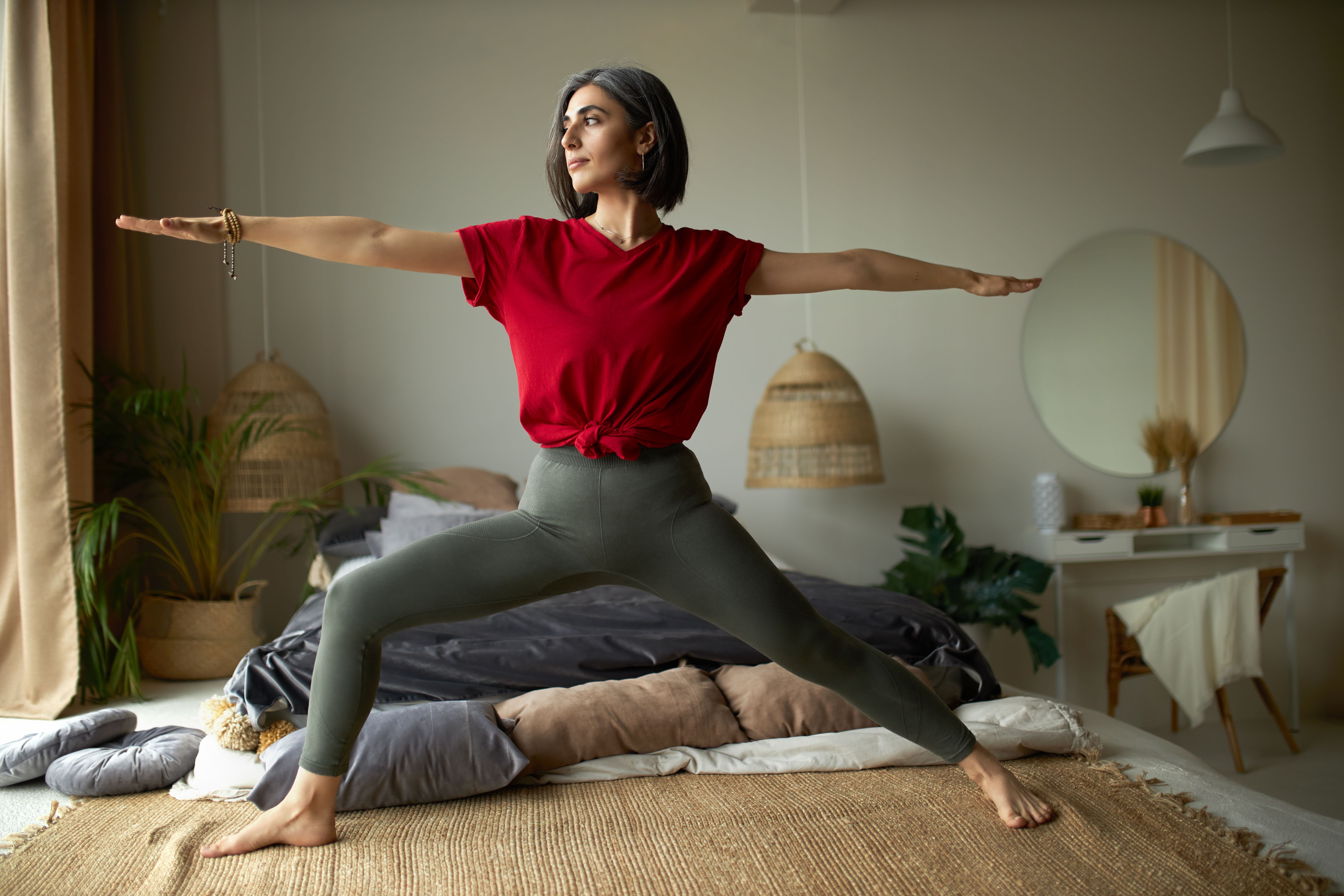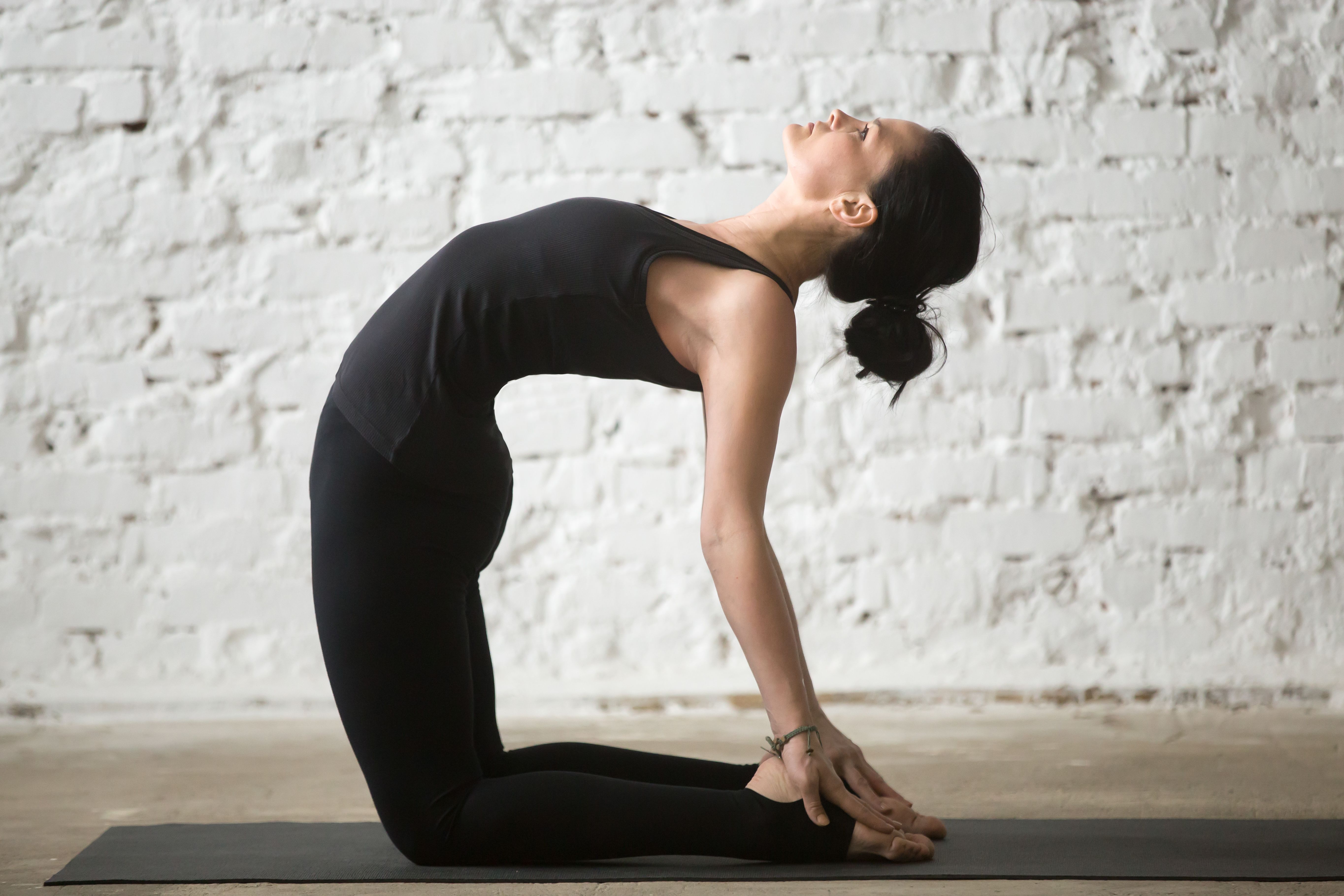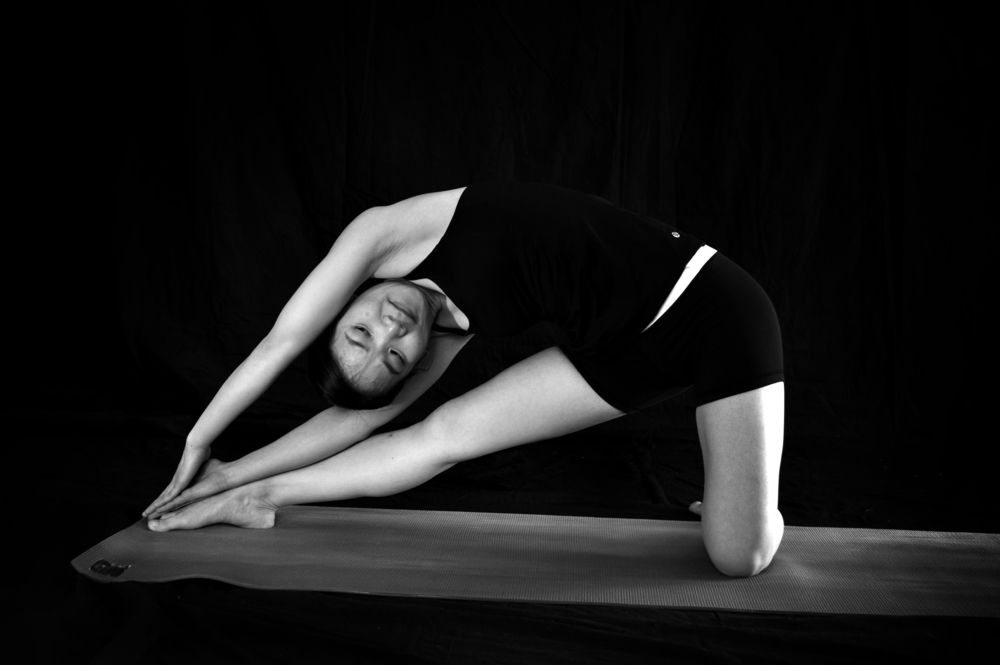What is Parighasana (Gate Pose)?

The Parighasana, or Gate Pose, is a kneeling stretch that targets the abdominal side muscles. It's a beginner to intermediate-level yoga pose.
This pose involves kneeling on the mat and straightening one leg sideways. As the arms are extended at the side, you will feel a deep stretch in your obliques.
Gate pose is excellent for those who wish to lose side belly fat or anyone who wants sculpted obliques.
Overview & Etymology
The word Parighasana comes from the Sanskrit language, which translates as 'Parigha' meaning gate closing bar and 'Asana' meaning position or posture.
Gate pose is a modern yoga asana, so it won't be found in any ancient Hatha yoga texts.
In a 1924 book, Primary Gymnastics by Niels Bukh, you can find many modern-day yoga poses – including the Parighasana inside.
It's said that Sri Tirumalai Krishnamacharya (Indian Yoga Teacher and Healer) derived the gate pose from gymnastic practice and introduced it in his teaching culture.
Sanskrit Name: परिघासन Pronunciation: Par-ee-GHA-AH-suh-nuh
Pose Type: Kneeling Side Stretch Also known as Gate Pose
Strengthens: Obliques, Hip-Flexors, Spinal Column, and Knees
Stretches: Inner Thighs, Obliques, Chest, Hamstrings, Spine, Groin, and Intercostals Muscles
Health Benefits of Parighasana
Strengthens and tones the obliques.
Lengthens and strengthens the spine.
Improves spinal range of motion and posture.
Expands the lungs and stretches the intercostal muscles
Stimulates the digestive system and enhances its functioning.
Stimulates the heart chakra and increases the flow of energy in the body.
Has therapeutic effects on mild back pain and inflammatory bowel disease.
When to Avoid Performing Parighasana
Avoid if you are suffering from a hernia.
Avoid if you have chronic low back pain.
Avoid if you have had a recent injury or surgery.
Avoid if you have weak knees or knee arthritis.
Avoid after the second trimester of pregnancy.
How to do Parighasana (Gate Pose)
The Gate pose practice is divided into four phases: warm-up poses, primary pose practice, alignment tips, and relaxation poses:
Part 1 - Preparatory Poses for Parighasana
The following are a few yoga poses that will help you activate important muscle groups like your spine, obliques, hip flexors, knees, and hamstrings. Warming up these muscle groups encourages flexibility and range of motion for the main Gate pose practice:
1. Virabhadrasana II (Warrior Pose II) - This pose will help you improve side body balance and strengthen your quads and knees. Start in the Tadasana position and step your feet 3-4 feet apart.
Raise your arms at your sides to shoulder height, keeping your palms facing down to the ground. Turn your right foot out 90 degrees so that your heel is in line with the arch of your left foot.

Then, turn your left foot 45 degrees. Bend your right knee over your right ankle aligning your thigh parallel to the ground. Ensure that your knee is aligned over your ankle and that your left leg is straight behind you. Gaze over your right hand. Hold the pose for 5-10 breaths, then repeat the same on your other leg.
2. Parivrtta Janu Sirsasana (Revolved Head to Knee Pose) - Start by sitting in the wide-angle seated pose with the toes pointing toward the ceiling. Bend your left leg and bring your foot close to your groin, and keep your right leg straight at your side.

Now, gently rotate your tailbone to the right side, extend your left arm overhead, and bend your body sideways onto your right leg. Hold your right toe with your left hand, and maintain this pose for a few seconds.
Repeat the same on the other side. This seated hip opener provides a deep stretch to your side body, pelvis, hip flexors, and hamstrings.
3. Ustrasana (Camel Pose) - This is an intermediate-level back stretch, so performing this pose is optional. Start from a kneeling position and position your knees hip-width apart. Tighten your core, arch your back and pull your tailbone close to your navel.

Gently, bend your neck back, place your arms behind you and hold both ankles with your fingers. Maintain this pose for a few seconds. This position will activate your lower back, spine, quads, neck, and core.
Part 2: Step-by-Step Instructions to Perform Parighasana
The following are steps to perform Parighasana or Gate Pose:
Step 1- Start by kneeling on the yoga mat and keeping your toes curled behind you.
Step 2- Next, extend your right leg on your right side, and rotate your right knee and right toe toward the ceiling. Keep kneeling on your left leg.
Step 3- Inhale deeply and raise your left arm over your head. Hold the pose here for a few seconds while you reach for your left ear.
Step 4- Now, gaze in the direction of your left arm overhead, exhale, and bend your upper body toward your right leg.
Step 5- Bend only to the extent your body feels comfortable. You can also rest your right hand on the yoga mat for added support.
Step 6- Hold this position on each side for a few breaths and relax.
Inhalation: While kneeling on the mat and raising one arm overhead.
Exhalation: Exhale while bending your upper body sideways.
Performance Duration for Beginners: Hold Parighasana for 5-10 deep breaths on each side.
Performance Duration for Advanced: Hold Parighasana for 1-5 minutes on each side.
Part 3: Things to Keep in Mind
If you want to make your Gate pose practice experience more beneficial and safe, follow these important alignment cues:
Keep your back straight: While performing Gate pose, make sure to keep your spine upright and in line with your neck and glutes. Do not slouch your shoulders or curve your spine – this will not help you lengthen your spine or open the chest properly.
Do not overstretch: Overstretching can cause serious wear and tear in the muscles. While bending your upper body on each side, observe how your oblique muscles feel. If it's too painful to lean at your side, then do not overstretch. Instead, try to modify the pose with props or handheld support from your yoga teacher.
Do not drop your upper body forward: Most beginners make the mistake of bending their upper body forward as they flex sideways. Even a slight bend forward can target the wrong muscle groups. Also, it will not help you strengthen or tone your side abs and it can cause lower back pain. As you bend sideways, gaze up in the direction of your extended arm and keep your body bent at the side, not in front.
Part 4: Relaxing Poses After Parighasana
It's important to rest your obliques and decompress the build-up of tension around your spine and knees after you practice Gate pose. Here are a few counter poses to try:
1. Balasana (Child's Pose) - From the kneeling position, now place your hands on the floor and get into the tabletop position. Inhale into the tabletop pose and exhale slowly as you bring your glutes to sitting between your thighs and your forehead resting on the mat.

Keep your arms extended forward, take a few deep breaths, and relax your shoulders, glutes, back, and abdomen. Hold this pose until you feel comfortable and relaxed around your back.
2. Shavasana (Corpse Pose) - To release this pose and any remaining tension from the knees, quads, tailbone, and upper body, get into the corpse pose. Lie down on your yoga mat facing the ceiling, close your eyes and feel your breath passing through your whole body.

Maintain this semi-sleep pose for 5 to 10 minutes to help relax your entire body all at once. Also, it will help you bring your spine back to its neutral position.
Parighasana Variations to Consider
There are many variations that you can do to enhance your Gate pose practice. Here are some of the most popular:
1. Parighasana Variation (Gate Pose Resting Arm Variation) - If you're starting Gate pose as a beginner and lack the strength to bend sideways, it's highly recommended that you keep your overhead arm pointed straight up and the other arm resting on the ground.

This variation allows beginners to open their side bodies without any overstretching in the muscles. Also, regular practice of this modification will help you bring more balance and strength to your primary pose practice.
2. Parighasana Variation (Gate Pose Deep Variation) - If you feel strong and stable in your primary Gate pose practice, you can gently deepen your side bending even further.

For this variation, continue the Gate pose, raise both your arms overhead in prayer formation, and start to hinge sideways. Rest your upper body over your extended leg at your side and hold this pose here for a few seconds on each side.

Enjoy a Free 1-on-1 Session with a Coach!
Receive personalized guidance tailored to your unique fitness goals, live with a dedicated coach—no credit card required.
Frequently Asked Questions about Parighasana
Parighasana Ashtanga or Gate Pose is a kneeling side stretch that targets your obliques, spine, neck, tailbone, shoulders, and knees. Mastery over this pose over time will help you strengthen and tone all the above-mentioned areas.
Parighasana is a combination of two Sanskrit words, 'Parigha', which means crossbar (the bar that's used to close the gate), and 'Asana', which means position.
Parighasana should not be practiced with low-side abdomen flexibility. This pose may not be the perfect choice for beginners, but newbies can start with modified Gate pose variations to build mobility and strength in their obliques and then slowly move to the main practice.
It's a wise choice to warm up your legs, knees, spine, abs, and obliques in Warrior Pose II, Revolved Head to Knee Pose, and Camel Pose before getting started with Parighasana practice. This will ensure you don't injure yourself during the main pose practice.
Gate Pose with a Deep Side Bend for advanced yogis or Gate Pose with a Resting Arm on the yoga mat for newbies are a few commonly used posture variations in Parighasana.
The following are some benefits of Parighasana:
- Tones the side waist.
- Reduces low back pain.
- Increases flow of Prana.
- Mobilizes the knee joints
- Stretches intercostal muscles.
- Lengthens the body sideways.
- Increases strength and flexibility in the obliques.
- Stretches the abductors, quads, and hip flexors.



.webp)
%20(7).jpg)




